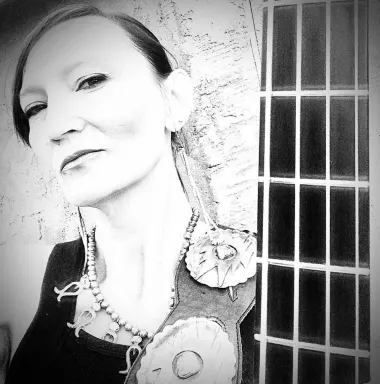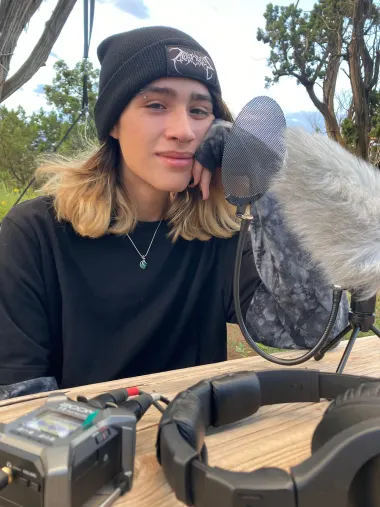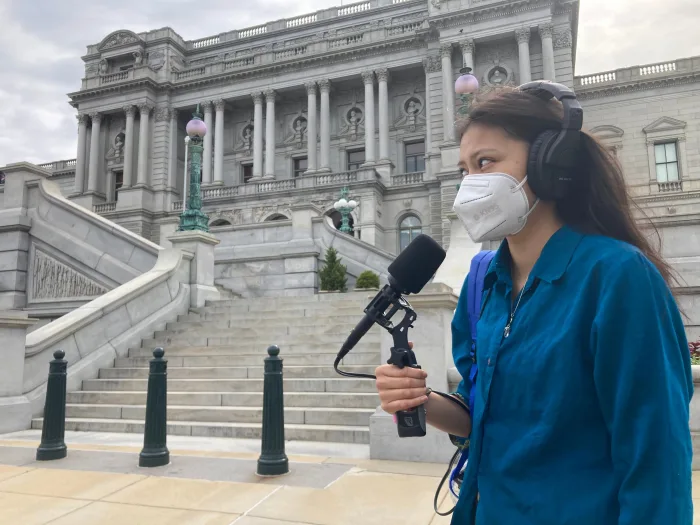New radio show taps into Native youth culture
Sandra Hale Schulman
ICT

A new radio program, “Indigenous YOUth Nation,” is aimed at Native youths in remote locations where radio plays an important role. Here, producer Gregg McVicar explains details of audio recording to four participants, from left, Bahiyyah, Dahi, Deezhchiil and Bahozhoni. (Photo courtesy of Jeneda Benally)
On remote reservations, radio — not internet and podcasts — is the dominant form of communication. For many remote locations, there is no internet.
With that in mind, Jeneda Benally, Diné, a multi-award winning musician/singer/ songwriter with Sihasin and Blackfire, teamed up with Peabody Award-winning producer Greg McVicar, Tlingit, to create a new radio show aimed at young people.

The program, “Indigenous YOUth Nation,” or IYN, is a 29-minute radio show that engages tweens and teens about their own Indigenous culture with support from Native media professionals.
Created to celebrate culture, empower youth and nourish knowledge, the teen hosts take listeners on journeys that venture into the cultural and creative lives of various people to break down stereotypes, Benally said.
“Indigenous YOUth Nation is my personal response to all of the news coming out finally about the children that were victims of boarding schools, that were buried in mass graves and brutalized for speaking their language, for celebrating and living their cultural identity,” Benally told ICT from Arizona.
“How do we heal from this?”
Benally has been empowering youth through her band and with workshops in tribal communities, and realized she wanted a show in which youths told their own stories.
“How do we heal from this?”
Benally has been empowering youth through her band and with workshops in tribal communities, and realized she wanted a show in which youths told their own stories.
“The radio is incredibly important for so many rural Indigenous nations that don’t have access to internet,” she said. “ And those are the voices that we wanted to help uplift. Those are the voices, the identities, that we wanted to work hard on normalizing culture with and inspiring that intergenerational dialogue between youth and elders.”
Benally said the pilot show focused on Diné youth, with eight different segments that included traditions, language and music.
“We wanted it to be fun and quick with the attention span of a teenager,” Benally said.
Learning the ropes
The pilot episode includes a feature with 12-year-old Deezhi sharing a “Day in the Life” audio diary of her kinaaldá, or coming-of-age ceremony, and hears how 16-year-old Dahi discovers a deeper connection to her tribe and ancestors by traveling to the Library of Congress in Washington, D.C.
Sixteen-year-old Ashkii, Diné, did a segment on elder wisdom. A music segment featured an interview with CJ Ramone, of the punk rock group, The Ramones. Benally knew him from recording and doing concerts with him and his band.

“He was part of our workshop to talk about some of his least-liked interviews and some of his best interviews,” Benally said.
McVicar gave the youths field-recording equipment and went on the trips to show them how to use it.
“They were really starting at the beginning,” McVicar told ICT from his studio in California. “What I was trying to do is give them confidence. ‘You guys are going to do fine; it’s not that hard. And just be yourselves.’ That’s really what we wanted to come across, as who they are and what their interests are. Don’t try to fit into some mold of what being on the radio sounds like.”
He said the youths were very quiet, very shy, but listened closely and picked up on techniques.
“The best part for me was when we had all this tape from interviews,” he said. “Now we have to boil it down, find the good stuff and throw away the rest. Editing is not just using software to cut audio. Editing is deciding how to tell the story and what to leave in, what to take out and how to frame it so that it makes the most sense for the listener at home.
“They really got into it,and it was great to watch them start evaluating and discussing among themselves about what decisions to make,” he said.
The youths agreed that they learned from the experience.
“Through Indigenous YOUth Nation, I have learned about radio and sound production as well as its recording process,” said Bahozhoni, 16, a host and Youth Advisory Council member. “ I also learned more about what it means to be Indigenous and how other people express that and share who they are through many different ways and forms of storytelling.”
Mia Dove, Diné, 12, is on the Youth Advisory Council and suggested segment ideas.
“It was fun, educational and interesting all at the same time,” Dove said.
Deezhi, who did the day-in-the-life segment in the pilot, said she learned a few tricks of the trade.

“I learned to always have an extra recording so that if you lose one, you can always use the other one,” Deezhi said. “It was good to make this radio show so people can learn about their culture more.”
Benally said the show has no scripts, so it was important to keep them engaged.
“The kids were speaking from the heart,” Benally said. “If we needed something to transition, or to fill out for the listener at home, we’d get them talking. With one of the girls, I had her go in the booth. We had a microphone and I started asking her questions about why this? What do you feel about that? We used that, or parts of it.
“What’s really exciting about this show and the youth involvement is that it’s authentic,” Benally said.
Sharing Indigenous cultures
The pilot episode is being distributed throughout the public radio system via Native Voice One: The Native American Radio Network and PRX. She says there are a lot of non-Native stations interested in the programming.
Through her travels with her band Sihasin, Benally recently went to Peru and introduced the show there.
“I was in Peru through the State Department doing diplomacy through art and music,” Benally said. “We visited a school in the foothills of the Andes, and they were so curious about our culture, so we did a lot of workshops with them and they are continuing the conversation months later by having Indigenous YOUth Nation in their classroom.”
She said it’s important to share Indigenous culture across international borders.
“We’re really thrilled to be able to reach across the borders to normalize Indigenous culture because there’s so much shame associated with being a culture keeper,” she said, “with wearing your hair in a traditional way, with wearing your moccasins or with wearing jewelry that is identifiable in a cultural manner.”
She’s hoping to be able to expand the program.
“If somebody wanted to program it, we hope to do a series,” she said. “It’s a lot of work and it takes resources. We made a good solid pilot; I’m really proud of it. It’s something we can show around to the system and to potential funders and say, ‘Here’s the vision.’”
And she’s continuing to spread the word.
“Part of what we hope to do is to bring these workshops, to bring these radio shows, to Indigenous communities where we teach these important skills of storytelling, stepping outside the shyness shell, to feel empowered to ask these questions and to learn how to edit, to learn how to listen,” she said.
More infoRadio stations can request “Indigenous YOUth Nation” through Native Voice One. Workshops are also available for schools interested in the programming for cultural enrichment.“Indigenous YOUth Nation” was made possible with community radio support from KWMR in Point Reyes, California, and with a grant from the Joan Ganz Cooney Center at Sesame Workshop and the American Folklife Center at the Library of Congress.
External
The tree features names of missing Indigenous people
The billboard project is expanding to Oregon
Identification not yet made
UTTC International Powwow attendees share their rules for a fun and considerate event
Radio collaboration highlights importance of cooperation in a season of funding cuts for local media






